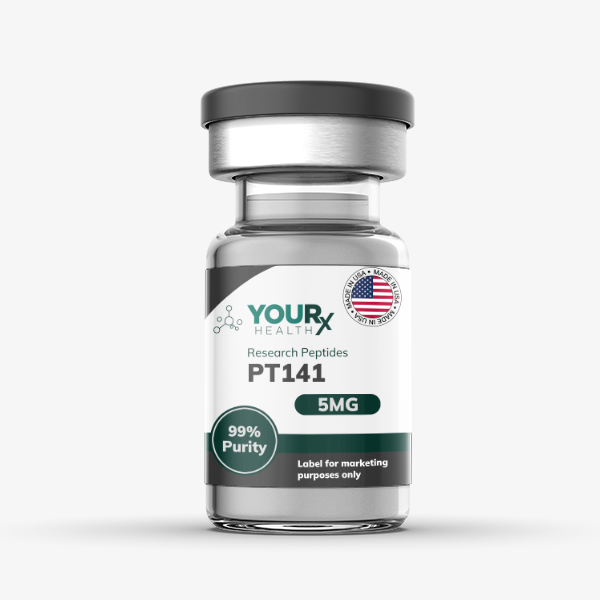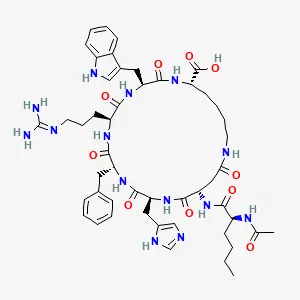
PT-141, also known as bremelanotide, is a peptide that has been the subject of research in phase IIb human clinical trials, exploring its potential in relation to sexual desire in females. This compound is a melanocortin that primarily binds to the melanocortin 4 receptor (MC-4R) and melanocortin 1 receptor (MC-1R). Additionally, in 2009, PT-141 was evaluated in studies related to the management of acute hemorrhage. PT-141 is a derivative of another synthetic melanocortin.
PT-141, also known as bremelanotide, is a peptide that has been the subject of research in phase IIb human clinical trials, exploring its potential in relation to sexual desire in females. This compound is a melanocortin that primarily binds to the melanocortin 4 receptor (MC-4R) and melanocortin 1 receptor (MC-1R). Additionally, in 2009, PT-141 was evaluated in studies related to the management of acute hemorrhage. PT-141 is a derivative of another synthetic melanocortin.

source PubChem
PT-141 is a distinct peptide that activates the MC-4R receptor, which is known to induce sexual arousal in the brain and affect sexual behavior[1], [2]. Research in animal models has shown that activation of the MC-4R receptor triggers sexual arousal and enhances mating behavior in both males and females[3], [4]. Unlike drugs such as Viagra, which work by improving blood flow to the genitals, PT-141 operates through a different mechanism. As a result, it holds potential for treating sexual arousal disorders in both men and women that are not related to blood flow issues.
In a clinical study of men with erectile dysfunction (ED) who did not respond to sildenafil (Viagra), about one third of participants were able to achieve a sufficient erection for intercourse when treated with PT-141 (administered as a nasal spray). The study also showed a strong dose-dependent response, suggesting PT-141’s efficacy in certain cases[]. This finding indicates that PT-141 could provide a solution for treating ED in cases where sildenafil has proven ineffective and could also help address central factors contributing to low sexual desire.
Studies have shown that the duration of penile rigidity greater than 60% was significantly higher with various doses of PT-141 compared to a placebo.
Despite promising results, PT-141 was withdrawn from clinical trials before it received approval for treating women with hypoactive sexual desire disorder (HSDD). Research indicated that PT-141 increased the frequency of satisfying sexual events and lowered distress scores related to sexual health in women, without significant side effects[6]. Many professionals treating female sexual dysfunction were disappointed by the termination of the trials, pointing to the lack of established endpoints for FSD trials and socio-cultural barriers against addressing women’s sexual health as the main reasons for the delay in approval[7]. These experts are calling for more attention to be given to the issue and for the development of clearer guidelines from the FDA on evaluating therapies like PT-141. They also believe that combining pharmacological treatments with established methods of addressing sexual dysfunction could be more effective and that PT-141 could help initiate the psychological treatment process.
In response to concerns over the termination of earlier trials, Phase II Reconnect studies were initiated in 2017, using subcutaneous PT-141 injections for FSD. The updated version of PT-141, known as Rekynda, could soon be available in the U.S., where it may be legally used off-label for both male and female sexual dysfunction[8]. These new trials have included modified endpoints that FSD experts believe will help bring such treatments to approval.
In 2009, PT-141 was slightly modified and investigated as a potential treatment for hemorrhagic shock. By binding to both the MC-1R and MC-4R receptors, it helps reduce ischemia and protect tissues from inadequate blood supply in cases of hypovolemic (hemorrhagic) shock. When administered intravenously, it does not produce significant side effects. This modified version of PT-141 is called PL-6983 and was last tested in Phase IIb trials.
The MC-1R receptor has been shown to have important anti-fungal and anti-inflammatory effects in a rat model of fungal infection[9]. This is especially significant since current anti-fungal treatments are limited in their effectiveness and often produce severe side effects in certain patients. PT-141 could offer a viable alternative for treating fungal infections, potentially reducing complications in patients with compromised immune systems.
The MC-1R receptor plays a crucial role in DNA repair pathways, making it relevant for cancer treatment and prevention[10]. Research suggests that individuals with variants of MC-1R may have a higher risk of basal cell and squamous cell carcinoma[11]. The modified version of PT-141 may be able to address these genetic variations, potentially preventing or treating these cancers.
While PT-141 has garnered significant attention for its potential in treating sexual dysfunction, its research applications extend beyond that area. For example, defects or absences of the MC-4R receptor are known to contribute to obesity, accounting for approximately 6% of early-onset cases. PT-141 may offer a unique opportunity to explore this cause of obesity and propose potential interventions. Additionally, the MC-1R receptor plays a role in pain, inflammation, kidney disease, and infection spread, areas in which PT-141 could offer valuable insights.
PT-141 has demonstrated minimal side effects, high oral bioavailability, and excellent subcutaneous bioavailability in animal models. However, the dosage used in animal studies does not directly translate to human applications.
(Note: PT-141 is restricted to educational and scientific research purposes only and should not be used for human consumption.)
This article was researched, edited, and organized by Dr. Logan, M.D., who holds a doctorate from Case Western Reserve University School of Medicine and a B.S. in molecular biology.
Dr. Sheryl A. Kingsberg is the chief of behavioral medicine at University Hospitals Case Medical Center and a professor in Reproductive Biology and Psychiatry at Case Western Reserve University. Her clinical specialties include sexual medicine, female sexual disorders, cognitive behavioral psychotherapy, and several other areas. Dr. Kingsberg has been involved in PT-141 research, particularly in female sexual disorders, and led a randomized, placebo-controlled dose-finding trial for this peptide. She has authored numerous publications and sits on the editorial boards of several medical journals.
Dr. Kingsberg is cited as one of the leading scientists involved in PT-141 research, though she does not endorse or support the purchase, sale, or use of PT-141 for any purpose outside of approved research settings.
ALL ARTICLES AND PRODUCT INFORMATION PROVIDED ON THIS WEBSITE ARE FOR INFORMATONAL AND EDUCATIONAL PURPOSES ONLY.
The products offered on this website are furnished for in-vitro studies only. In-vitro studies (Latin: in glass) are performed outside of the body. These products are not medicines or drugs and have not been approved by the FDA to prevent, treat or cure any medical condition, ailment or disease. Bodily introduction of any kind into humans or animals is strictly forbidden by law.
No COAs available for this product.